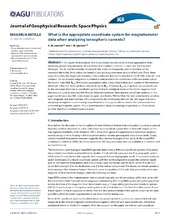| dc.contributor.author | Laundal, Karl Magnus | eng |
| dc.contributor.author | Gjerløv, Jesper | eng |
| dc.date.accessioned | 2015-03-17T15:19:22Z | |
| dc.date.available | 2015-03-17T15:19:22Z | |
| dc.date.issued | 2014-10 | eng |
| dc.identifier.issn | 2169-9380 | en_US |
| dc.identifier.uri | https://hdl.handle.net/1956/9564 | |
| dc.description.abstract | In this paper we investigate which coordinate representation is most appropriate when analyzing ground magnetometer data in terms of ionospheric currents, in particular the westward electrojet. The AL and the recently introduced SML index are frequently used as monitors of the westward electrojet. Both indices are based on ground magnetometers at auroral latitudes. From these magnetometers, the largest perturbation in the southward direction is selected as the AL/SML index at 1 min cadence. The southward component is defined as antiparallel to the orientation of the horizontal part of the Earths' main field, B0,H. The implicit assumption when using these indices as a monitor of the westward electrojet is that the electrojet flows perpendicular to B0,H. However, B0,H is, in general, not perpendicular to the westward direction in coordinate systems that take nondipole terms of the Earth's magnetic field into account, such as apex and the Altitude Adjusted Corrected Geomagnetic coordinate systems. In this paper we derive a new SML index, based on apex coordinates. We find that the new index has less variation with longitude and universal time (UT), compared to the traditionally defined SML. We argue that when analyzing ionospheric currents using magnetometers, it is appropriate to convert the components to a corrected geomagnetic system. This is most important when considering longitudinal or UT variations, or when data from a limited region are used. | en_US |
| dc.language.iso | eng | eng |
| dc.publisher | Wiley | en_US |
| dc.publisher | American Geophysical Union | en_US |
| dc.rights | Attribution-NonCommercial-NoDerivs CC BY-NC-ND | eng |
| dc.rights.uri | http://creativecommons.org/licenses/by-nc-nd/4.0/ | eng |
| dc.subject | auroral electrojet | eng |
| dc.subject | magnetometer | eng |
| dc.subject | ionospheric current | eng |
| dc.subject | apex coordinates | eng |
| dc.title | What is the appropriate coordinate system for magnetometer data when analyzing ionospheric currents? | en_US |
| dc.type | Peer reviewed | |
| dc.type | Journal article | |
| dc.date.updated | 2015-03-03T12:51:44Z | en_US |
| dc.description.version | publishedVersion | en_US |
| dc.rights.holder | Copyright 2014 The Authors | en_US |
| dc.identifier.doi | https://doi.org/10.1002/2014ja020484 | |
| dc.identifier.cristin | 1163477 | |
| dc.source.journal | Journal of Geophysical Research: Space Physics | |
| dc.source.40 | 119 | |
| dc.source.14 | 10 | |
| dc.source.pagenumber | 8637-8647 | |

